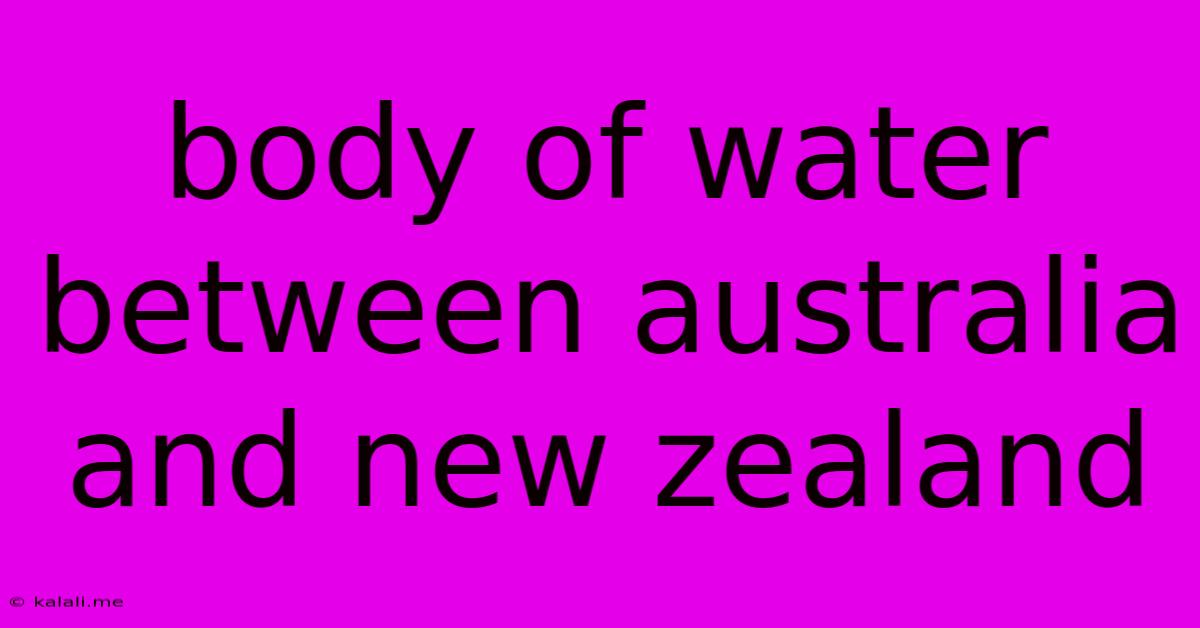Body Of Water Between Australia And New Zealand
Kalali
Jun 15, 2025 · 3 min read

Table of Contents
The Tasman Sea: Exploring the Body of Water Between Australia and New Zealand
The vast expanse of water separating Australia and New Zealand isn't just an empty ocean; it's the Tasman Sea, a significant body of water with a rich history, diverse marine life, and unique geographical features. This article will delve into the fascinating aspects of the Tasman Sea, exploring its geography, climate, ecology, and historical significance. Understanding the Tasman Sea is crucial for appreciating the relationship between Australia and New Zealand, two countries deeply connected by this impressive waterway.
Geography and Geology of the Tasman Sea
The Tasman Sea, named after the Dutch explorer Abel Janszoon Tasman, is a marginal sea of the South Pacific Ocean. It stretches approximately 2,000 kilometers (1,200 miles) across at its widest point and covers an area of roughly 2,300,000 square kilometers (890,000 square miles). Its boundaries are defined by the eastern coast of Australia, the southern coast of New Zealand, and the underwater ridges connecting these landmasses. The sea's depth varies considerably, ranging from shallow continental shelves to deep basins exceeding 5,000 meters (16,400 feet). The geological history of the Tasman Sea is complex, reflecting the movement of tectonic plates and the formation of the Australian and New Zealand landmasses. Underwater volcanoes and canyons further add to the sea's diverse geological landscape.
Climate and Ocean Currents
The Tasman Sea experiences a temperate climate, influenced by both subtropical and Antarctic air masses. This results in fluctuating weather patterns, with strong winds, occasional storms, and significant variations in temperature throughout the year. The sea is also influenced by powerful ocean currents, notably the East Australian Current and the Tasman Front. These currents play a crucial role in regulating the temperature and salinity of the water, influencing the distribution of marine life and impacting the climate of the surrounding regions. The East Australian Current, a warm current, flows southward along the Australian coast, while the Tasman Front represents a boundary between warmer subtropical waters and cooler subantarctic waters.
Marine Life and Ecology
The Tasman Sea supports a remarkably diverse range of marine life. Its productive waters are home to a multitude of fish species, including commercially important ones like tuna and snapper. Marine mammals, such as whales, dolphins, and seals, also inhabit these waters, utilizing the sea for breeding, feeding, and migration. The seafloor supports diverse benthic communities, from coral reefs in shallower areas to deep-sea ecosystems teeming with unique organisms. The Tasman Sea is also a crucial habitat for seabirds, many of which rely on the rich marine resources for food. Conservation efforts are essential to protect this vibrant ecosystem and ensure the long-term sustainability of its resources. Protecting marine biodiversity is vital for maintaining the health of this significant body of water.
Historical Significance and Navigation
The Tasman Sea has held significant historical importance, particularly in the context of exploration and trade. Abel Tasman's voyage in 1642 marked a pivotal moment in the history of European exploration of the region. His discovery helped chart the area and established a maritime connection between Australia and New Zealand. Understanding the currents and weather patterns of the Tasman Sea has been critical for safe navigation throughout history. The sea has also played a role in trade routes, linking Australia and New Zealand with other parts of the world.
Conclusion
The Tasman Sea is more than just a body of water; it's a dynamic ecosystem, a historical landmark, and a vital link between two significant nations. Its vastness, its diverse marine life, and its complex geological features make it a fascinating subject of study. Continued research and conservation efforts are crucial to understanding and preserving this remarkable part of the world's oceans. The future management of the Tasman Sea will require collaboration between Australia and New Zealand to ensure the sustainable use of its resources and the protection of its rich biodiversity.
Latest Posts
Latest Posts
-
Which Of The Following Pairs Is A Correct Match
Jun 16, 2025
-
What Type Of Membrane Is The Skin
Jun 16, 2025
-
Select The Correct Statement About Synapses
Jun 16, 2025
-
How Many Players On Hockey Team
Jun 16, 2025
-
What Is The Gap Between Two Neurons Called
Jun 16, 2025
Related Post
Thank you for visiting our website which covers about Body Of Water Between Australia And New Zealand . We hope the information provided has been useful to you. Feel free to contact us if you have any questions or need further assistance. See you next time and don't miss to bookmark.